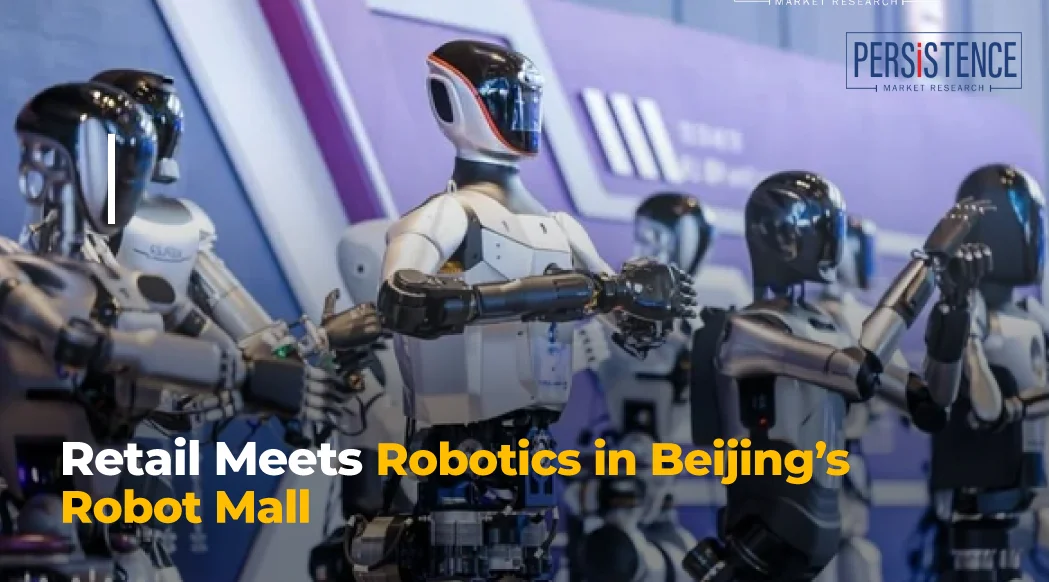- Blog
- Retail Meets Robotics In Beijings Robot Mall
Retail Meets Robotics in Beijing’s Robot Mall
Published On : 19 Aug 2025
Saunter into Beijing’s E-Town technology hub, and one might wonder if they have stepped onto the set of a high-budget sci-fi film. Rising from the district’s glass-and-steel skyline is Robot Mall Beijing, the world’s first humanoid intelligent robot 4S store, a concept borrowed from car dealerships’ sales, service, spare parts, and surveys (4S) framework, but reconceptualized for the age of AI. It’s a bold experiment in making humanoid robots as familiar to the public as home appliances.

Inaugurated during the 2025 World Robot Conference, the mall showcases more than 100 robotic models from nearly 200 brands. The lineup is strikingly diverse, with mechanical butlers gliding across tiled floors, robot dogs trotting alongside curious visitors, chess-playing machines coolly plotting their next move, coffee-making assistants behind café counters, and a remarkably lifelike Albert Einstein replica priced close to US$ 97,000. The experience has been kept deliberately interactive. Visitors can sip on a smooth latte concocted by a bot, compete with a humanoid in a game of Chinese chess, or hear a poetic recital from an animatronic Li Bai.
Towards a Holistic Robotics Ecosystem
Here, selling is only a small part of the plan. The 4S model lays great emphasis on providing post-purchase support, ensuring spare parts availability, and putting in place structured feedback loops, making this a rare retail format in the global robotics sector. By blending commerce with maintenance and customer engagement, China is laying the groundwork for a consumer robotics ecosystem that could accelerate trust in and adoption of bots among humans.
The mall also boasts a robot-themed restaurant where humanoid chefs prepare dishes and robotic servers deliver them to tables, working as an immersive test case for how automation might work alongside human staff in hospitality.
Power of the State
This maiden venture is a product of years of unwavering policy support extended by the Chinese government. In 2024 alone, China channeled over US$ 20 billion into subsidies specifically for robotics, with an AI and robotics fund worth US$ 137 billion waiting in the pipeline. The push for robotics is closely linked to national priorities, which primarily hover around overcoming slowing economic growth and supporting an aging population through automation. Officials stress a collaborative model in which robots take on repetitive, hazardous, or physically demanding jobs, freeing up human workers to focus on more strategic and creative tasks.
The high-profile launch of the mall as a part of an international event also serves the diplomatic function of boosting China’s soft power in technology. The likelihood of this strategy being replayed during other upcoming events such as the World Humanoid Robot Games, where bots will compete in athletics, dance, and even soccer, is ever so high, showcasing progress China has been making in AI-driven mobility and coordination.
Traversing the Factory Floor and Going Beyond
What distinguishes this project is the balance it strikes between the practical and cultural applications of robots. On the functional front, robots can perform everyday functions such as delivering pharmacy orders, sifting goods, or mixing cocktails. On the cultural side, they have the potential to bring historical and literary icons to life, adding an essence of nostalgia using advanced technology. This dual approach broadens the market appeal of robotics, targeting industries, households, and entertainment venues alike.
China’s near self-sufficiency in robotics components is there for everyone to witness. The country procures roughly 90% of the parts from domestic manufacturers and suppliers, offering a significant cost advantage to Chinese robotics companies. As manufacturing scales, analysts predict prices could fall by nearly 50%, helping the global humanoid market surpass one million units by 2030.
Not Without the Human Touch
Of course, much like any other technology, this one is not without its flaws. One café bot recently stalled mid-pour, coffee cup in hand, until staff reset its software, a stark reminder that even cutting-edge machines can be prone to quirkiness and idiosyncrasies. But these imperfections make the experience more human, molding public perception of robots from cold, hyper-efficient tools into approachable companions. Whether you leave with a mechanical Einstein for your study or as a collector’s item or simply the memory of a chess match lost to a steel opponent, the takeaway is unequivocal: the era of robots is already here, arriving circuit by circuit, interaction by interaction.
Industry Report

Request Report Sample
Your privacy is important to us; your data is secure
Contact Us
Latest Reports
-
Piezoresistive Pressure Sensor Market by Sensor Type (Absolute, Gauge, Differential, Sealed), Pressure Range (Low Pressure (<10 kPa), Medium Pressure (10 kPa – 1000 kPa), High Pressure (>1000 kPa)), End-Use Industry (Automotive & Transportation, Industrial Manufacturing, Healthcare, Aerospace & Defense, Electronics) and Regional Analysis for 2026-2033
-
Aquarium Accessories Market by Product Type (Filtration Items, Lights & Hoods, Temperature Control Systems, Others), End-User (Residential, Commercial), Distribution Channel (Online, Offline), and Regional Analysis for 2026-2033
-
Oxygen Therapy Market by Product Type (Compressed Oxygen, Concentrated Oxygen, Liquid Oxygen), Disease (Respiratory Disorder, Cardiovascular Disease, Sleep Apnea, Pneumonia), End-User (Hospitals, Home Healthcare, Clinics), and Regional Analysis for 2026-2033
-
Air Curtains Market by Product Type (Non‑Recirculating, Recirculating, Heated, Others), Airflow Capacity (Up to 500 m³/h, 500–1000 m³/h, 1000–1500 m³/h, Above 1500 m³/h), Application (Commercial, Industrial, Residential, Others), and Regional Analysis for 2026–2033
-
Personalized Stationery Market by Product type (Storage & Filling Products, Paper-Based Products, Drawing & Writing Instruments, Accessories, Bags, Others), Application (Educational Institutes, Corporate Offices, Personal Use, Hospitals, Others), and Regional Analysis for 2026–2033
